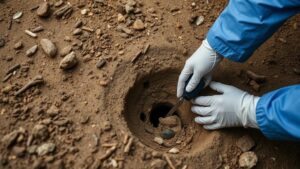Recovering Pottery Shards in Forest Floors Covered by Seasonal Leaves
Recovering Pottery Shards in Forest Floors Covered by Seasonal Leaves
The recovery of pottery shards from forest floors obscured by seasonal leaves is a complex yet rewarding endeavor in the field of archaeology. The presence of natural leaf litter presents both challenges and opportunities in the excavation and identification of this important cultural material. This article explores the methodologies, challenges, and case studies related to recovering pottery shards in such environments.
Understanding the Importance of Pottery Shards
Pottery shards, or potsherds, are remnants of ceramic vessels that hold significant archaeological value. can provide insight into cultural practices, trade networks, and technological advancements of past societies. For example, studies have shown that variations in pottery styles often reflect socio-economic conditions, religious practices, and even climate changes within a given period. According to the Society for American Archaeology, pottery analysis contributes to over 40% of archaeological interpretations in certain regions.
The Challenges of Recovery
Recovering pottery shards from forest floors blanketed by seasonal leaves can be particularly challenging due to several factors:
- Visibility: The layer of leaves can obscure smaller artifacts, making them difficult to spot.
- Disturbance: Natural elements might disturb the stratigraphic context of the shards, complicating accurate dating and interpretation.
- Environmental Conditions: Moisture from fallen leaves can affect the preservation of pottery, making shards brittle or causing further degradation.
Effective Recovery Techniques
To overcome these challenges, archaeologists employ a variety of effective recovery techniques:
- Troweling: Utilizing trowels and other hand tools allows for a careful excavation of leaf layers without disturbing underlying soil structures.
- Screening: Useing metal screens or mesh can help sift through leaf litter and soil, increasing the chances of uncovering smaller shards.
- Soil Sampling: Collecting soil samples from specific layers can sometimes yield micro-finds through flotation methods, revealing tiny pottery fragments.
Case Studies: Successful Recoveries
Several archaeological projects illustrate successful recovery of pottery shards in leaf-covered forest floors:
The Savanah River Archaeological Project
In Georgia, USA, the Savanah River Archaeological Project implemented systematic grid excavation methods in dense forest areas. team employed careful troweling and precision screening techniques. Over years of excavation, they were able to recover thousands of pottery shards, revealing a timeline of ceramic production spanning from 1000 BCE to European contact.
The Guatemalan Maya Project
An archaeological survey in Guatemala’s lowland rainforests discovered that traditional clearing methods were inefficient. Researchers adapted methods by introducing controlled leaf litter removal and excavation protocols. This systematic approach led to the identification of multiple ceremonial pottery pieces that contributed to the understanding of Maya ritual practices.
Preservation of Finds
Post-recovery, it is crucial to implement preservation techniques to ensure longevity of the artifacts:
- Cleaning: Gently cleaning shards with soft brushes and distilled water can help remove debris without damaging the material.
- Documentation: Comprehensive documentation, including photographs and notes on the shard’s context, is vital for future analysis.
- Storage: Storing artifacts in climate-controlled environments and using appropriate materials (such as acid-free boxes) protects against deterioration.
Actionable Takeaways
For archaeologists working in wooded areas with seasonal leaf cover, the following takeaways can enhance the recovery of pottery shards:
- Use systematic excavation practices to minimize disturbance to the forest floor.
- Incorporate technology such as drones or ground-penetrating radar to assist in planning excavation sites.
- Engage local communities to create awareness about the importance of pottery recovery, potentially increasing volunteer support.
The recovery of pottery shards from forest floors covered by seasonal leaves not only enriches academic knowledge but also enhances cultural heritage conservation. By employing careful methodologies and keen observation, archaeologists can effectively navigate these challenging environments to uncover valuable historical narratives.

